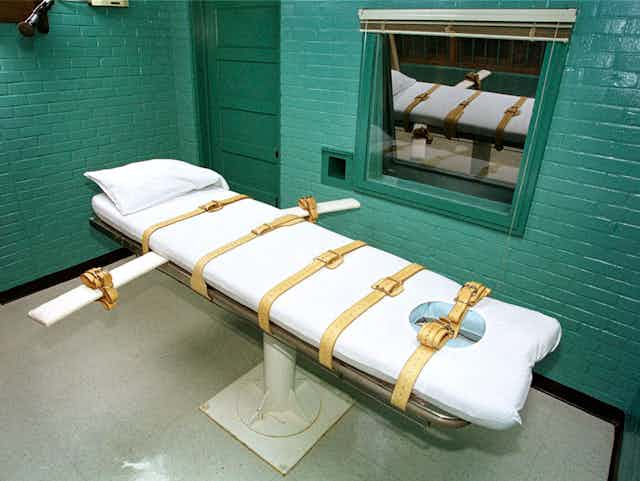If a majority of the Supreme Court justices eventually strike down the death penalty as unconstitutional, Henry Lee McCollum may be an important reason why. Perhaps that will provide some small comfort to him, given the 30-year ordeal he suffered on death row in North Carolina as an innocent man.
McCollum and his brother, Leon Brown, had falsely confessed to the murder of a 11-year-old girl. They were young, intellectually disabled, and they quickly recanted their confessions as having been forced on them by the local police, who used overbearing interrogation tactics. Last year, when DNA testing on evidence that had remained hidden for decades finally exonerated them, the results implicated another man, a serial murderer. Both men have now been pardoned.
In one of the last opinions announced by the Supreme Court this Term, in Glossip v Gross, by a 5-4 margin the Court approved the lethal injection “cocktail” now being used in Oklahoma and other states. What makes the case so important, though, were the defensive remarks by justices in the majority, who perhaps now sense that the days of the death penalty are numbered.
In his remarkable dissent, Justice Stephen Breyer, joined by Justice Ruth Bader Ginsburg, argued that the death penalty is flat-out unconstitutional. Justice Breyer explained just how rare and unusual death sentences are, raising serious concerns under the Eighth Amendment, but also a dilemma: the very delays that prolong litigation in death penalty cases, also result in remarkable number of reversals and outright exonerations of innocent prisoners. And Justice Breyer cited the case of Henry McCollum, noting how in 1994, the Supreme Court denied relief in his case, over the dissent of just one justice.

At the time, Justice Antonin Scalia loudly proclaimed that the death penalty was richly merited in “the case of an 11-year old girl raped by four men and then killed by stuffing her panties down her throat. How enviable a quiet death by lethal injection compared with that!” It took 20 additional years for DNA to prove that McCollum was innocent. No comment from Justice Scalia.
False confession cases such as McCollum’s show it is inevitable that innocent people will be sentenced to death. Death penalty cases often heavily revolve around confession evidence. One half of the 20 cases of individuals exonerated by DNA testing from death row in the US included false confessions. Each of those confessions supposedly included specific details of the crime that only the murderer could have known.
The police claimed that Brown and McCollum had each separately told them in gruesome detail how the victim had been raped and murdered, including how she was asphyxiated by her own panties: we now know that they were innocent and their confession statements were contaminated – meaning that police must have actually told the brothers each of those facts during the interrogation.
Confession contamination
Such confession contamination has happened in case after case. I have found that almost without exception, the false confessions by DNA exonerees were contaminated. Of 69 false confessions, 65 had been contaminated. Nineteen of these exonerees who had falsely confessed were even convicted despite DNA tests that cleared them at the time of trial – such is the power of confession statements, even false ones.
Indeed, in a 1997 death penalty case, that of Damon Thibodeaux, police did not conduct DNA tests that would have proved his innocence, because they had secured his (false) confession (54 minutes were recorded of his nine-hour interrogation).

At his trial, the prosecutor explained that if “somebody confesses” you do not “need DNA to tell you” who the culprit is. And police still fail to record entire interrogations; videotaping who said what in the interrogation could help to prevent confession contamination.
Death penalty cases continue to centre on confession evidence. In Virginia, I have found that seven of the 20 capital cases that have gone to trial since 2005 have involved confession statements, most of which were undocumented.
Far broader studies of murder cases have found similar figures. Professor John Donohue, in his important study of the Connecticut death penalty, found 59% of death eligible murders since 1973 involved confession statements made to the authorities, and in addition, 43% involved incriminating statements to third parties.
The classic study lead by Professor David Baldus of the Georgia death penalty found that 29% in a sample of 1,066 murder and voluntary manslaughter cases involved self-incriminating statements.
Snitched up
Why do many capital cases have confessions? Police may be particularly keen to conduct lengthy coercive interrogations in capital cases. Henry McCollum knows this well. And still more death penalty cases involve confession statements supposedly made to informants or jailhouse “snitches” (of the 20 DNA-related exonerations in death penalty cases, ten involved testimony by informants).
Around the world, the most serious murders are often “solved” using interrogations and confessions. In Japan, Iwao Hakamada spent a horrifying 47 years on death row based on a false confession, until DNA tests exonerated him. Indeed, in Japan – and Japan is far from alone in this respect – nearly all criminal cases generally rely on confessions to police.
Interrogations themselves can be improved through safeguards such as videotaping. But the death penalty itself cannot be made foolproof – and indeed, high-profile murder investigations may be even more prone to tragic errors.
This is a problem internationally and in any criminal justice system, since error is inevitable. The death penalty makes those errors irreversible and in the most serious criminal cases. As most states in the US have realised, as most of the globe has realised – and as four US Supreme Court justices seem to have realised: the death penalty is broken and it cannot be fixed.

